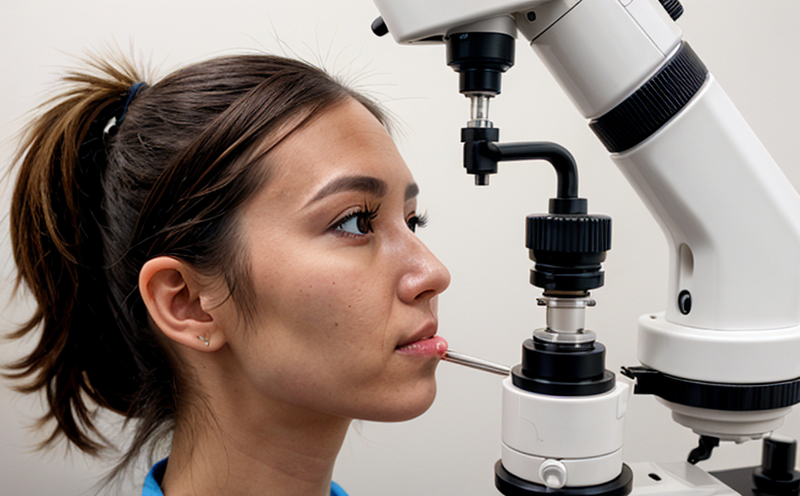ISO 11979-8 Intraocular Lens Fundamental Requirements Testing
The ISO 11979 series of standards provide guidelines and requirements for intraocular lenses (IOLs) used in ophthalmic procedures. Specifically, ISO 11979-8 details the fundamental requirements that ensure IOLs are safe and effective during their intended use. This standard is crucial for medical device manufacturers, quality managers, compliance officers, and R&D engineers who need to validate the safety and performance of ophthalmic devices.
The testing outlined in ISO 11979-8 covers a range of critical parameters that ensure an IOL's suitability for use. These include material compatibility with human tissues, biocompatibility, optical characteristics, stability under various conditions, and more. The primary goal is to minimize risks associated with the insertion and long-term use of intraocular lenses.
The testing process involves multiple steps, each designed to evaluate a different aspect of the IOL's performance. Materials must undergo biocompatibility tests to ensure they do not cause adverse reactions in patients. Optical properties such as light transmittance, contrast sensitivity, and glare control are also rigorously assessed. Additionally, mechanical stability and durability under stress conditions are evaluated.
Once the materials have been tested for their fundamental requirements, a detailed report is generated that includes all test results. Compliance with ISO 11979-8 ensures that the IOL meets stringent international standards, which enhances patient safety and trust in medical device manufacturing processes.
In summary, adhering to these tests guarantees that ophthalmic devices are safe for clinical use, minimizing risks such as adverse reactions or mechanical failures. This standard is vital for ensuring that intraocular lenses meet the highest quality and safety benchmarks required by regulatory bodies worldwide.
Testing Parameters
The detailed testing parameters outlined in ISO 11979-8 are critical to ensure the safety, efficacy, and reliability of ophthalmic devices. The following sections provide a comprehensive overview of these tests:
- Biocompatibility Tests: These evaluate how well the material interacts with biological tissues over time.
- Optical Properties: This includes measurements of light transmittance, contrast sensitivity, and glare control to ensure optimal visual outcomes.
- Mechanical Stability: Tests assess the lens's resilience under various stress conditions to determine its durability over time.
- Stability Under Conditions: Evaluates how well the IOL maintains its properties under different environmental and usage conditions.
Specimen Preparation
Proper specimen preparation is essential for accurate testing. Specimens are typically prepared in a controlled environment to simulate real-world conditions as closely as possible. Materials used must be of high quality, free from defects that could affect test results. Once prepared, specimens undergo a series of tests designed to evaluate their fundamental requirements.
This includes detailed examinations using advanced instrumentation such as microscopes and other specialized equipment. The precision with which these tests are conducted is paramount in ensuring accurate and reliable data. Compliance officers and R&D engineers rely on this rigorous testing process to ensure that IOLs meet all necessary safety and performance criteria.
Benefits of ISO 11979-8 Intraocular Lens Fundamental Requirements Testing
The implementation of ISO 11979-8 testing offers numerous benefits to medical device manufacturers, healthcare providers, and patients alike. By adhering to these standards, companies can ensure that their intraocular lenses meet the highest quality and safety benchmarks required by regulatory bodies worldwide.
- Enhanced Patient Safety: Rigorous testing minimizes risks such as adverse reactions or mechanical failures, ensuring safer outcomes for patients.
- Increased Regulatory Compliance: By adhering to international standards, companies ensure that their products meet all necessary regulatory requirements.
- Improved Product Quality: The testing process identifies any potential issues early on, allowing manufacturers to address them before product release.
- Enhanced Patient Trust: Compliance with these standards enhances patient confidence in the safety and efficacy of medical devices.
In summary, ISO 11979-8 testing provides a robust framework for evaluating the fundamental requirements of intraocular lenses. This ensures that manufacturers produce high-quality products that meet stringent international standards, thereby enhancing patient safety and trust.
Industry Applications
| Application | Description |
|---|---|
| Biocompatibility Testing | Evaluates the interaction of materials with biological tissues to ensure they do not cause adverse reactions. |
| Optical Properties Evaluation | Determines light transmittance, contrast sensitivity, and glare control for optimal visual outcomes. |
| Mechanical Stability Testing | Evaluates the lens's resilience under various stress conditions to ensure durability over time. |
| Stability Under Conditions Assessment | Ensures that IOLs maintain their properties under different environmental and usage conditions. |
- Biocompatibility: Ensures the material interacts safely with biological tissues over time.
- Optical Properties: Evaluates light transmittance, contrast sensitivity, and glare control for optimal visual outcomes.
- Mechanical Stability: Tests resilience under various stress conditions to ensure durability over time.
- Stability Under Conditions: Ensures properties are maintained under different environmental and usage conditions.
The application of ISO 11979-8 testing is critical for ensuring the safety, efficacy, and reliability of intraocular lenses. This standard provides a robust framework for evaluating fundamental requirements, enhancing patient safety and trust in medical device manufacturing processes.
International Acceptance and Recognition
The ISO 11979-8 standard is widely recognized and accepted by regulatory bodies and healthcare professionals globally. Compliance with this standard ensures that intraocular lenses meet the highest quality and safety benchmarks required by these entities.
- Regulatory Bodies: International standards like ISO 11979-8 are often referenced in regulatory guidelines, ensuring consistency across different regions.
- Healthcare Professionals: Compliance with these standards enhances trust and confidence among healthcare providers who rely on them for safe and effective medical device selection.
The acceptance of ISO 11979-8 is a testament to its effectiveness in ensuring the safety, efficacy, and reliability of intraocular lenses. By adhering to this standard, manufacturers ensure that their products meet the highest quality and safety benchmarks required by regulatory bodies worldwide.





